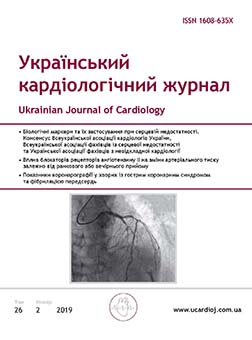Clinical and instrumental characteristics of patients with chronic heart failure and reduced left ventricular ejection fraction depending on weight loss within the previous 6 months
Main Article Content
Abstract
The aim – to compare the clinical and instrumental parameters of patients with chronic heart failure (CHF) and reduced left ventricular ejection fraction (LVEF) depending on weight loss within the previous 6 months.
Materials and methods. A total of 100 patients aged 32–75 years with CHF, II–IV functional classes (FC) by NYHA with LVEF ≤ 35 % were examined. The criterion for the distribution of patients into groups was a weight loss ≥ 6 % of the total weight over the past 6 months in accordance with the European guidelines for the diagnosis and treatment of CHF. Data on body weight loss dynamics over the past 6 months were obtained from anamnestic data and medical records of patients. Patients in the state of clinical compensation were included in the study.
Results and discussion. Weight loss ≥ 6 % within the previous 6 months was observed in 47 (47.0 %) patients. There was no statistically significant dependence of body weight loss ≥ 6 % on sex, the main clinical and hemodynamic parameters, function indicators and left ventricular remodeling, the structure of the previous treatment, the basic indices of general and biochemical blood tests, and the state of the renal nitrogen function. At the same time, the group of patients with a weight loss ≥ 6 % over the past 6 months was characterized by a statistically significantly higher proportion of persons who had III–IV FC by NYHA (p=0.001). Patients with body weight loss ≥ 6 % were statistically significantly older by age (p=0.044), had lower quality of life according to MLHFQ questionnaire (p=0.001) and lower index of household physical activity (p=0.001), higher score on the Beck Depression Inventory (p=0.005) and DEFS questionnaire (p=0.002), larger right ventricle (p=0.024) and systolic pulmonary pressure (p=0.008), higher level of C-reactive protein – C–RP (p=0.002), worse flow-dependent vasodilation (FDVD) (p=0.002) compared to patients without such a sign. The number of lost kilograms in the last 6 months directly correlated with the degree of deterioration in the quality of life (r=0.450; p=0.001), the number of points on the scale of tiredness from physical activity (r=0.302, p=0.002), the size of the right ventricle (r=0.269; p=0.009), the levels of C-RP (r=0.261; p=0.009), blood potassium (r=0.235; p=0.019) and systolic pressure in the pulmonary artery (r=0.230; p=0.027), the number of scores on the Beck Depression Inventory (r=0.227, p=0.023), and inversely related with the level of FDVD (r=–0.345; p=0.001), the magnitude of the excursion of the tricuspid ring
(r=–0.337, p=0.017), the level of sodium of blood (r=–0.245; p=0.014), the number of points in Duke university questionnaire (r=-0.240; p=0.016) and blood cholesterol (r=–0.192; p=0.036).
Conclusions. Patients with CHF and body weight loss ≥ 6 % were statistically significantly older by age, they were more likely to register NYHA III–IV FC, they had poorer quality of life, lower physical activity, and estimated maximum oxygen consumption, higher scores by the Beck Depression Inventory and the questionnaire on fatigue from physical activity, lower levels of cholesterol and plasma triglycerides, larger right ventricle and pulmonary artery systolic pressure, and a lower TAPSE score than patients without such a sign. Body mass loss ≥ 6 % is associated with a higher level of C-RP, as well as worse FDVD.

